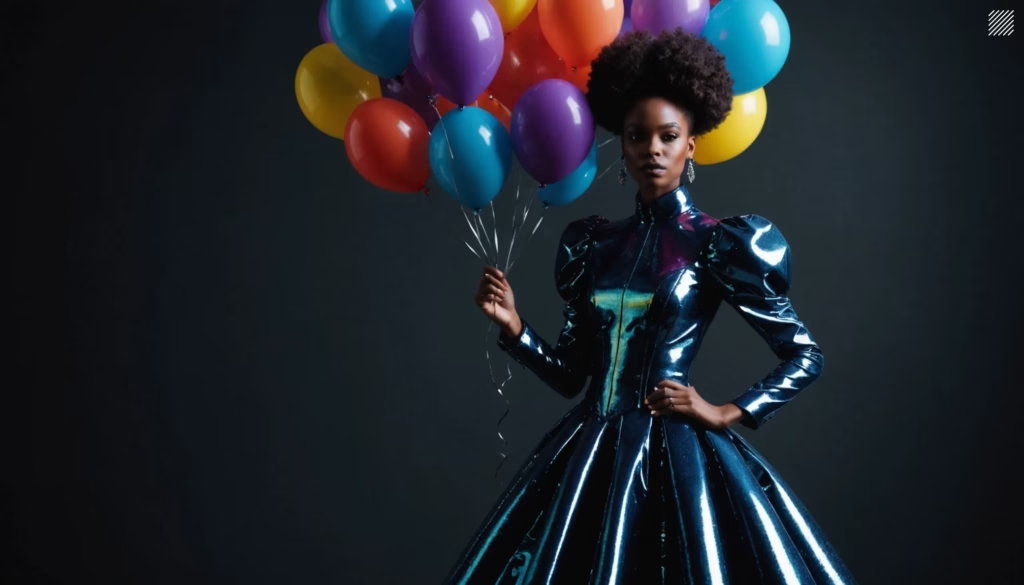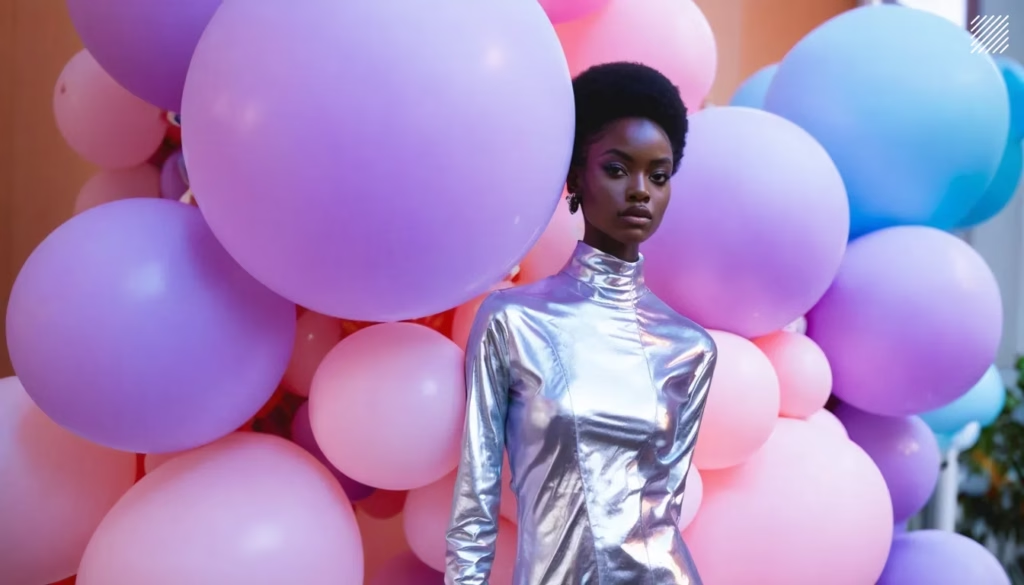
In the ever-evolving landscape of fashion, where innovation is the lifeblood that keeps trends alive and consumers engaged, a new frontier has emerged – the realm of generative artificial intelligence (AI). This transformative technology is poised to redefine the creative process, empowering fashion designers and brands to push the boundaries of what is possible.
Generative AI, a subfield of machine learning, has the remarkable ability to generate original content, from text and images to music and even 3D models. By training on vast datasets, these AI systems can learn the underlying patterns and structures that govern creative expression, and then leverage that knowledge to produce novel and imaginative outputs.
For the fashion industry, the implications of generative AI are profound. From AI-driven pattern making and garment design to AI-generated fashion illustrations and runway shows, this technology is set to revolutionize the way we conceive, create, and experience fashion.
AI in Fashion Design: Unlocking New Frontiers of Creativity
One of the most exciting applications of generative AI in fashion is its ability to assist and augment the design process. Traditionally, fashion design has been a highly skilled and labor-intensive endeavor, requiring designers to meticulously sketch, drape, and pattern-make each garment. However, with the advent of AI-powered design tools, this process is being streamlined and elevated to new heights.
AI-Driven Pattern Making and Garment Design
At the forefront of this revolution are AI-powered pattern making and garment design software. These tools leverage machine learning algorithms to analyze vast datasets of historical fashion designs, identifying the underlying geometries, silhouettes, and construction techniques that define various garment styles.
By inputting basic design parameters, such as the desired garment type, fit, and fabric characteristics, designers can task the AI system to generate a range of pattern options and design iterations. This not only accelerates the prototyping phase but also introduces fresh perspectives and unexpected design solutions that may have eluded human designers.
One such example is the work of Amnon Shashua, the co-founder and chairman of Mobileye, an Intel company. Shashua has developed an AI-powered platform that can generate original garment designs by learning from a database of existing patterns and styles. “The AI is able to take these patterns and recombine them in novel ways, creating new silhouettes and designs that a human designer might not have thought of,” Shashua explains.
This technology has far-reaching implications, from enabling smaller brands and independent designers to explore new design avenues without the investment of traditional pattern-making, to empowering large-scale fashion houses to rapidly prototype and iterate on collections.
AI Image Generation for Fashion Illustrations
Beyond pattern making and garment design, generative AI is also revolutionizing the way fashion illustrations and visuals are created. AI-powered image generation tools, such as DALL-E and Midjourney, can transform simple text prompts into stunning, photorealistic fashion sketches, product shots, and even full-fledged runway scenes.
By training on vast datasets of fashion imagery, these AI models have developed an innate understanding of the visual language of fashion – from the drape of fabrics and the flow of silhouettes to the nuanced details of accessories and styling. When provided with a text prompt, the AI can then generate highly compelling and unique fashion visuals that capture the essence of the designer’s vision.
This capability opens up new avenues for fashion brands and designers to bring their ideas to life, even before a single stitch is sewn. Designers can now experiment with different garment concepts, color palettes, and styling options without the need for traditional illustration skills or costly photoshoots.
Moreover, AI-generated fashion visuals can be leveraged for a wide range of applications, from product imagery and runway presentations to social media content and e-commerce experiences. This democratization of fashion visualization empowers even smaller players to compete with established brands in the digital realm.
Generative Design in Apparel: Pushing the Boundaries of Creativity
While AI-driven pattern making and fashion illustration represent significant advancements, the true power of generative AI in fashion lies in its ability to push the boundaries of creative expression. Generative design, a process where AI algorithms explore a vast design space to generate a multitude of unique solutions, is poised to transform the way we approach apparel design.
By feeding generative design systems with parameters such as user preferences, material constraints, and sustainability goals, fashion designers can task the AI to generate a myriad of design concepts that would be nearly impossible to produce manually. These AI-generated designs can then be further refined, iterated upon, and ultimately brought to life through the traditional design and manufacturing processes.
One example of this is the work of Zara’s innovation lab, which has been exploring the use of generative design algorithms to create new clothing patterns and silhouettes. “Our goal is to harness the power of AI to unlock new creative avenues and push the boundaries of what’s possible in fashion design,” explains the lab’s lead researcher.
Similarly, luxury brand Prada has been experimenting with generative design to create limited-edition capsule collections. By feeding the AI system with brand guidelines, material constraints, and sustainability targets, the system generates a range of unique designs that are then evaluated and refined by the brand’s design team.
“Generative design allows us to explore a wider design space and come up with solutions that may have eluded our human intuition,” says Prada’s head of innovation. “It’s an invaluable tool that enables us to create truly innovative and sustainable fashion products.”
AI Creativity in Fashion: Embracing the Future of Design
As generative AI continues to evolve, its impact on the fashion industry is likely to extend far beyond pattern making, garment design, and visual representation. This transformative technology is poised to redefine the very essence of creativity in fashion, challenging traditional notions of authorship and artistic expression.
AI-Driven Runway Shows and Fashion Presentations
One exciting frontier of AI-powered creativity in fashion is the potential to generate entire runway shows and fashion presentations. By training AI systems on historical fashion shows, catwalk choreography, and styling trends, these algorithms can autonomously conceive and produce captivating fashion presentations that blend cutting-edge technology with the artistry of human designers.
Imagine a future where an AI system, informed by a brand’s design aesthetic and sustainability objectives, creates a fully-fledged runway show – from the selection of garments and models to the music, lighting, and staging. This AI-driven approach not only streamlines the production process but also introduces an element of spontaneity and unpredictability that can captivate audiences and challenge traditional notions of fashion presentation.
“The idea of an AI-generated fashion show might seem far-fetched, but the technology is already here,” says Eran Yariv, the founder of a generative AI company working with fashion brands. “By combining AI-powered design tools, computer vision, and generative algorithms, we can create truly innovative and engaging fashion experiences that push the boundaries of what’s possible.”
Collaborative AI-Human Creativity
As generative AI continues to mature, fashion designers and brands will likely embrace a more collaborative approach, where human creativity and AI-driven innovation work in tandem to produce truly groundbreaking fashion designs and experiences.
In this symbiotic relationship, designers can leverage the AI’s ability to rapidly generate and iterate on design concepts, freeing up their time and mental bandwidth to focus on the higher-level creative direction and the emotional and cultural resonance of the final products.
“The role of the designer is not to be replaced, but rather to be elevated,” explains Amnon Shashua, the AI pioneer behind the pattern-making platform. “By working alongside AI systems, designers can focus on the strategic and visionary aspects of their craft, while the AI handles the more tedious and time-consuming tasks of pattern generation and prototyping.”
This collaborative approach can also foster newfound creative synergies, where the unpredictable and serendipitous outputs of the AI system inspire human designers to explore uncharted creative territories. The interplay between human intuition and AI-driven innovation has the potential to yield fashion designs that are not only aesthetically captivating but also imbued with deeper meaning and cultural relevance.
The Ethical Considerations of Generative AI in Fashion
As the fashion industry embraces the transformative potential of generative AI, it is crucial to address the ethical considerations that come with this technology. Issues of data privacy, algorithmic bias, and the potential displacement of human labor must be carefully navigated to ensure that the benefits of AI-driven innovation are realized in a responsible and equitable manner.
Data Privacy and Transparency
The training of generative AI models relies on vast datasets of fashion imagery, designs, and consumer behavior. Ensuring the ethical and secure use of this data is paramount, as fashion brands and designers must uphold the privacy rights of their customers and collaborators.
Transparent data collection and usage policies, as well as robust data governance frameworks, will be essential in building trust and maintaining the integrity of the fashion industry’s relationship with its stakeholders.
Algorithmic Bias and Inclusive Design
Like any machine learning system, generative AI models can perpetuate biases present in their training data, potentially reinforcing narrow definitions of beauty, body type, and cultural representation in fashion. Fashion brands and designers must proactively address these issues by incorporating principles of inclusive design and actively seeking to diversify the data and perspectives that inform their AI-driven creative processes.
“It’s not enough to simply harness the power of generative AI,” cautions Eran Yariv. “We have a responsibility to ensure that this technology is used in a way that promotes greater inclusivity, representation, and accessibility in fashion.”
Implications for Fashion Industry Employment
The integration of generative AI into the fashion design workflow raises valid concerns about the potential displacement of human labor, particularly among traditional pattern makers, illustrators, and other technical roles. Fashion brands and technology providers must work closely with industry stakeholders to develop upskilling initiatives, job transition programs, and collaborative models that empower human designers to thrive alongside AI-driven innovation.
“The goal is not to replace human designers, but to augment their capabilities and free them up to focus on the most meaningful and high-value aspects of their craft,” explains Amnon Shashua. “By investing in the education and training of designers, we can ensure that they are equipped to harness the power of generative AI in service of their creative vision.”
The Future of Fashion: AI-Powered Creativity and Innovation
As the fashion industry continues to evolve, the integration of generative AI into the design process is poised to become an increasingly prevalent and transformative force. From AI-driven pattern making and garment design to AI-generated fashion illustrations and runway presentations, this technology is unlocking new frontiers of creative expression and innovation.
By embracing the collaborative potential of human designers and AI-powered systems, fashion brands can cultivate a synergetic relationship that pushes the boundaries of what is possible in the realm of apparel design and fashion presentation. At the same time, it is crucial that the fashion industry addresses the ethical considerations surrounding data privacy, algorithmic bias, and the implications for human employment, ensuring that the benefits of AI-driven innovation are realized in a responsible and equitable manner.
As the fashion industry stands at the precipice of this technological revolution, the future holds the promise of even more breathtaking and imaginative fashion, where the lines between human creativity and artificial intelligence blur, giving rise to a new era of sartorial expression and innovation.


